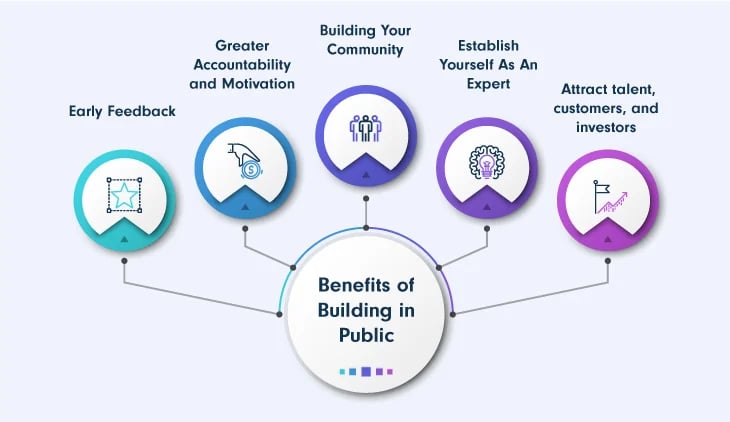Dropping the Veil: Building Your SaaS In Public

There was a time when soon-to-be entrepreneurs would guard their ideas from prying eyes with their lives, if necessary. Not anymore, though. Today, it’s all about transparency. SaaS founders are eager to share their journey of turning an idea into a stable subscription revenue stream while taking their community along for the ride. How is that possible? Through the now popular building in public strategy.
Even though having everything out in the open sounds like pure madness, this trend is growing in popularity. Yes, it is powerful enough to spark excitement among a growing user base, but only if it’s applied correctly. Otherwise, it could backfire horribly. So let's dive in and figure out the ins and outs, do’s and don’ts of building in public and decide whether it fits your SaaS.
What is Building in Public, and Why Do it?
Building in Public (BIP) is the practice of building a product, app, or company out in the open transparently. Founders that are into this strategy are all about sharing the behind-the-scenes struggles, learnings, wins, and, yes, failures as well.
This movement is quite a change from the secrecy in which founders used to prefer working. The so-called stealth mode means that startups would remain in a state of utter isolation from curious eyes so their idea would not be stolen. As time moved on, the benefits of BIP and open startups outweighed the risk of having an idea copied by other founders. From direct user feedback to growing a strong sense of brand authenticity and community, building in public is now the poster child of start-up development. But let’s have a closer look at the benefits involved when going fully transparent.
Why Choose BIP?
The best part of building in public is that I can stop relying on my brain. - Kevon Cheung
Yes, you read that right. Building in Public isn't a documentary people buy tickets to watch silently. It's not about you being an expert in a specific field, having the information advantage and showcasing your knowledge.
It’s about being you -real and authentic - setting off on one of your greatest journeys and getting insights and feedback from your target audience, whether this is made up of your potential customers or interested, like-minded entrepreneurs.
Early Feedback. When you are first-hand involved in developing a product, it can be difficult to notice usability issues. That’s when BIP comes in handy. Because when you are using open communication channels with both your potential customers and other SaaS founders, you obtain fresh perspectives, leading to less wasted time and, above all else, better-functioning products.
Greater Accountability and Motivation. Building products is tough. The journey can be a long one, and oftentimes, founders do get lost. When you share your progress publicly, a sense of accountability takes hold of you. The fact that others are watching your journey makes you stay motivated and committed to achieving your goals.
Building Your Community. The so-called “Building in Public” strategy fosters the growth of support groups and communities made up of loyal followers who will turn into paying customers and hopefully brand ambassadors. Establishing connections the right way, involving your potential users in your journey, and asking for feedback and recommendations builds trust in your product.
Establish Yourself As An Expert. You might not be an expert when you start your build-in public journey, but you will be by the time you finish. Recognition comes faster if you are operating within a niche. The more visibility you gain, the greater your reputation will be. And putting modesty aside, with an expert status come serendipitous opportunities, anything from possible collaborations to speaking engagements and partnership opportunities are all feasible.
Attract talent, customers, and investors. Investors, clients, employees, and collaborators highly appreciate transparency, and building in public revolves around this concept. Plus, the more exposure you obtain, the more people will want to join your project. Customers providing feedback will feel like they are part of the product creation process and will be eager to invest in it. Partners and investors will want to be involved in your product and transparency breeds trust, which strengthens business relationships.

10 Successful Examples of Building in Public
Since real-life examples are the best form of strategy validation, here are founders who have put the BIP technique to work successfully.
Buffer By Joel Gascoigne. Joel Gascoigne, together with the Buffer team, completely embraced the building in public strategy, and the result was well worth their entrepreneurial journey. They shared their product roadmap, regularly requested user feedback, and published blog posts about the lessons learned.
CopyAI By Paul Yacoubian & Chris Lu. In 2020, CopyAI was launched on Twitter. Since its launch, this marketing tool has managed to skyrocket, hitting $157,000 + MRR. The entire journey was followed by a close community throughout the building in public strategy deployment.
ConvertKit by Nathan Barry. Since 2013, when ConvertKit was created, Nathan Barry has been refreshingly open about his journey, exactly as one would expect from the company’s founder going the build-in public road. With an MRR of $ 2,464,976, the company has shared insights and growth metrics in a number of ways, from podcasts to blog posts and interviews.
Potion By Noah Bragg. Considering the no-code hype that’s taken over the world right now, it doesn’t surprise anyone that a no-code site builder for Notion users would hit some pretty impressive milestones. When Noah Bragg started their building in public journey, the goal was clear: sharing knowledge while making a profit. With Potion making $5K in MRR and a number of stories to document the journey, it would seem that this site-builder has achieved both goals.
Ghost By John O’Nolan. Ghost, the open-source publishing platform allowing users to create and manage their websites and blogs, was launched in 2013 by John O’Nolan, using the BIP strategy. The team has been very open about product development, sharing updates on their blog or social media channels and even involving the community in the decision-making process.
Web3Jobs By Andrey Azimov. Andrey Azimov used the BIP technique to create their online job-hunting platform, Web3Jobs. This very niche platform connects Web3 experts with startups and companies seeking their services.
Sales.co by Jakob Greenfeld. Jakob Greenfeld is a dedicated entrepreneur and tech founder that has launched Sales.co, a platform using cold emails to obtain SaaS meetings for interested clients. Happy to share his business insights and journey into building amazing products, Jakob Greenfeld created a newsletter and blog definitely worth following.
EverythingMarketplaces by Mike Williams. Created in 2020, EverythingMarketplaces is now the go-to place for marketplaces founders and teams. Mike Williams is behind this successful platform, using the building in public approach to document the making process.
Trello by Joel Spolsky and Michael Pryor. Trello, the very popular project management tool allowing users to organize and collaborate on tasks, was founded using the building in public strategy. As a matter of fact, today, Trello supports founders that wish to take the same road through different dedicated features.
Nomad List by Pieter Levels. Nomad List is a hugely popular platform that offers information and resources for digital nomads, including everything from city guides to community forums. Its founder, Pieter Levels, documented the entire creation process - sharing updates, revenue numbers, and even challenges faced and solutions.
Building in Public 101: The Pieces of Puzzle
Just like any other successful launch plan for a new product, building in public has its own set of rules. Because this strategy revolves more around who you are as a founder and the personal journey you’ve embarked on, the build-in-public game only has two fundamental rules: the content and the channels you use to share it. So, let’s uncover the secrets of efficient building in public.
1. Mind Your Content
Before we move on to describing what kind of content is generally used in this approach, we need to mention an extra step. Your compass on this transparent journey needs to be your ultimate goal. Figure out what you want to achieve by creating a building in public campaign, and only after, decide on the content type you want to share and the channel to share your thoughts.

2. Choose Your Channels Wisely
Because of the popularity of this strategy, founders have an abundance of tools ready to empower their BIP efforts. Of course, one, in particular, stands out, and that is Twitter, specifically Twitter threads, but there are others worth using too.
No matter how tempted you might be to make use of all of them, try to refrain from doing that. Achieving channel fit is what matters here - both founder and market.
So, after you’ve gotten to know your options, focus on:
The type of content you are most comfortable with ( building in public is a long-term effort, so you need to be able to create powerful content in a professional manner).
The channel you believe fits your business and audience best.

The Dos & Don’ts Of Building In Public
Tips And Tricks
Content and Channel Matter
You might have heard that whatever channel works, so simply go with the flow. We’re here to tell you that it matters, as well as content type. The way you present your ideas, from the channel to the format you use to put the information out there, determines the amount of visibility your posts have. And that’s the key to building in public successfully. Your storytelling might be valuable, but as long as you are without an audience, then you won’t be achieving your goals.
Be consistent
Goals on the road to achievement cannot be achieved without discipline and consistency - Denzel Washington
Rome wasn’t built in a day, and nor will your brand. Consistency is extremely valuable, and no matter how difficult it might seem at times, you need to continue putting content out there. It takes time to build credibility and trust, but ultimately, you will win your audience.
Engage with Customers
The two important goals of this approach are building solid products and strong audiences. How can you achieve it? Simple ( at least in theory), by igniting conversations. However, you need to understand that communication is a two-way street. If you ask for feedback and receive it, be sure to test it. Customers are invested in your building in public journey, helping you create awesome products, and they will take it personally if they think their opinion doesn’t matter.
Learn From Your Mistakes
Remember when we mentioned that building in public isn’t only for experts? It’s a self-discovery journey, not a masterclass in eCommerce. You will gain points if you fully acknowledge your mistakes, try to figure out solutions and document this part of the experience as well. Don’t try to hide it. It’s what makes you look human, invested in your project, and dedicated to bringing forward truly qualitative products.
Know When The Journey Ends
Building in public is a highly rewarding launch strategy both for you and your products. But the emphasis is on launch, which means that at some point, you will need to pull the plug on your information sharing or at least adjust the content and frequency. When your brand is launched, some details need to be kept private so they don’t interfere with your SaaS success.
Also, when that happens, you need to correctly monetize your product. Check out our SaaS pricing guide to find out how to complete this process effectively.
Mistakes to Avoid
Not All Outcomes Can Be Monetized
A lot of eager founders join the Building in Public game in the hopes of finding new revenue streams, whether these come in the form of partnerships or potential customers. Unfortunately, there is a high probability that won’t happen. A lot of the people following you on your build in public journey aren’t going to pay for the product. It’s a fact. You need to take this in and adjust your expectations. Building in public is more about creating interactions than driving revenue.
Not Everything Is For Sharing
It’s very important to make the distinction between what needs to be shared and what is not. Sometimes, keeping things behind closed doors isn’t such a bad thing. In fact, it’s advisable. Yes, BIP is all about being transparent and taking people along with you on what should be an interesting journey. But that’s the thing. Not everything that is going to happen in the BIP experience is valuable. So, try to keep users hooked by bringing forward useful information and avoid boring them by giving them every single detail of the process.
There’s More To BIP Than The Destination
Usually, it’s the journey that matters, but in BIP, the destination tends to shape the road. However, things are a bit more complicated. This experience is also about you. Try to avoid following trends. Video content might be king, but if you are not comfortable with that exposure level, then go for a different channel. The point is to offer your audience valuable information naturally so you can sustain your efforts in the long run.
BIP Common Struggles
Even though building in public is on the minds of many, many founders, there are entrepreneurs that have decided to take a step back and move away from this approach. Are they right? Is there something wrong with the build in public movement? Let’s find out!
It’s Just Hard
Finding the motivation to keep on posting and sharing ideas can be difficult, especially if this is your first project. The whole point of applying this strategy is to promote yourself as an expert, and that can be challenging to achieve with everything else that product development entails. Creating awesome content, finding the right channel, and targeting the correct audience is hard work, and it’s even tougher when you inevitably hit those low points and feel unappreciated. Not everyone can handle it.
Self-Doubt is Real
Self-doubt, mixed with the fear of failure and coupled with the crippling effects of procrastination, come together and create the not-uncommon impostor syndrome. While we are not saying that there is something wrong with you if you don’t take up building in public, we do think that self-doubt is powerful enough to make talented founders stay off the field and turn into bench warmers.
Idea Thieves Are Everywhere
Yes, having your idea stolen by some of the members of your build in public fellowship can occur. But then again, having your content stolen is a real possibility once you have launched your product, so it’s not like you can completely avoid it. The only problem is that if you don’t filter what you are going to share with your community, you might lose your product’s uniqueness. A bit of self-control is a way to obtain some intellectual security. So, be sure to adjust your content if you want to keep your secrets truly secret.
The #Buildinginpublic frenzy
These days, every piece of information, every product presentation, tweet, everything is labeled as building in public. This makes your audience pull away and look for highly specific content. If you’re not careful, before you get to the point of offering your followers real tips and insights that make a difference, you won’t have an audience to address.
Is This Approach Suitable For SaaS Products?
Absolutely! The building-in-public approach can be highly effective for SaaS because of the software product’s lifecycle, which involves the following phases:
Idea Development and Validation
Prototype Building
Messaging
Product Building
Product Launch
Product Improvement
Building in public can be extremely advantageous in any of these steps, allowing SaaS founders not only to gather information and relevant, applicable feedback with a huge potential to significantly improve the product but also to raise a community of potential early adopters.
So if you think about it, building in public for SaaS is a powerful combination of product development and strategic marketing.
Unlock unprecedented growth with our Merchant of Record model. From simplified tax and compliance management to global payments and automated billing, PayPro Global takes care of everything for you.
Focus on your product. We’ll handle the rest.
How Can PayPro Global Help?
When building your SaaS in public, it is vital that entrepreneurs develop the post-launch process early to make sure they can monetize it as fast and streamlined as possible. You are building the hype, so you might as well capitalize on it. The approval process, as well as payment processing, system integration, and subscription management, are just some of the challenges that build in public founders are faced with. Through its all-in-one eCommerce solution, PayPro Global supports SaaS entrepreneurs in launching their products and growing their revenues.
With access to our unique MOR model, packed with relevant features like global tax and compliance handling, subscription management, fraud detection, and prevention systems, cross-border payments, localized processing catering to customer payment preferences worldwide, and more, we are sustaining and encouraging founders to create their product and leave the financial and operational technicalities to the experienced PayPro Global team.
Additionally, our solution offers extensive reporting, making it easy for you to analyze different metrics, including tracking SaaS revenue recognition, and plan data-driven growth strategies. With a complete developer’s documentation and an assisted integration process, we make it simple for you to connect your business to our systems and start selling immediately.
By having a strong relationship with PayPro Global, SaaS founders can effectively engage with their communities, grow into global markets without encountering any billing issues and continue their building in public endeavors, knowing that their payment operations are handled efficiently and securely.
Get in touch with us to investigate our strengths and how they may fit your needs in obtaining a unified eCommerce payment solution.
Final Thoughts
Building in public is undoubtedly a highly popular business practice, successfully used by most entrepreneurs these days to obtain product market fit and immediate feedback. But is the hype real? For tech startups and service providers, in particular, the benefits outweigh the risks and challenges.
If done right, if the content is adjusted to fit the goals, the channels are selected adequately, if there is discipline and consistency on your end, and if you have a solid partner by your side that can sustain your efforts and take the workload of selling products online off your shoulders, then the building in public strategy is for you! If not, the building process could get extremely difficult.
Startup founders need to consider SaaS trends and organize their thought processes if they want to receive feedback early. After all, what is BIP if not the fastest way to complete extensive market research projects and ultimately achieve SaaS product-market fit? They need to be ready to simply expose honest updates and talk about challenges or bugs their new products have developed, as this is what an open startup is all about, transparency.
Ioana Grigorescu
Ioana Grigorescu is PayPro Global's Content Manager, focused on creating strategic writing pieces for SaaS, B2B, and technology companies. With a background that combines Languages and Translation Studies with Political Sciences, she's skilled in analyzing, creating, and communicating impactful content. She excels at developing content strategies, producing diverse marketing materials, and ensuring content effectiveness. Beyond her work, she enjoys exploring design with Figma.
-
1.Explore PayPro Global's Solutions: See how our platform can help you streamline your payment processing and boost revenue.
-
2.Get a Free Consultation: Discuss your specific needs with our experts and discover how we can tailor a solution for you.
-
3.Download our Free Resources: Access valuable guides, checklists, and templates to optimize your online sales.
-
4.Become a Partner: Expand your business by offering PayPro Global's solutions to your clients.
Get the latest news



